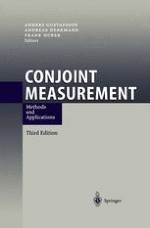2003 | OriginalPaper | Chapter
Latent Class Models for Conjoint Analysis
Authors : Venkatram Ramaswamy, Steven H. Cohen
Published in: Conjoint Measurement
Publisher: Springer Berlin Heidelberg
Included in: Professional Book Archive
Activate our intelligent search to find suitable subject content or patents.
Select sections of text to find matching patents with Artificial Intelligence. powered by
Select sections of text to find additional relevant content using AI-assisted search. powered by
Conjoint analysis was introduced to market researchers in the early 1970s as a means to understand the importance of product and service attributes and price as predictors of consumer preference (e.g., Green and Rao 1971; Green and Wind 1973). Since then it has received considerable attention in academic research (see Green and Srinivasan 1978, 1990 for exhaustive reviews; and Louviere 1994 for a review of the behavioral foundations of conjoint analysis). By systematically manipulating the product or service descriptions shown to a respondent with an experimental design, conjoint analysis allows decision-makers to understand consumer preferences in an enormous range of potential market situations (see Cattin and Wittink 1982; Wittink and Cattin 1989; and Wittink, Vriens, and Burhenne 1994 for surveys of industry usage of conjoint analysis).
